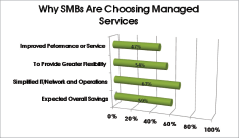
OUTSOURCING ISN’T A DIRTY WORD:
MEET YOUR IT TEAM’S NEW BEST FRIEND – MANAGED SERVICES
INTRODUCTION
Small-to-medium-sized businesses (SMBs) generally don’t have the resources to fully support all IT infrastructure needs. Even if your business has one or several in-house IT technicians on payroll, they’re often so bogged down by routine daily tasks that their talent is wasted. The very core of your business infrastructure is jeopardized if they’re overworked and vulnerable to error. This employee isn’t adding nearly as much value to your business as it should be. It’s not a good place for them or you.
According to the research group Gartner, over 65% of IT budgets go towards tasks that do nothing more than keeping the lights on. This means SMBs investing in their technology aren’t necessarily improving operations and efficiency or enhancing their security. They’re just keeping the wheels turning.
The concept of “managed services” has evolved through the last decade. Today, managed service providers (MSPs) are being used by small businesses to cost-effectively manage, service, and support their IT processes. MSPs are often called in as an alternative to adding additional in-house staff. Unfortunately, this also means MSPs are typically seen as a threat to the job security of any IT employee that fears they’re about to be replaced by “outsourced” help.
In this e-guide, we will explain how a hybrid approach, utilizing managed services, cloud services, and internal IT support can truly be the best of all worlds. They simultaneously help SMBs achieve a greater return on investment (ROI) on their IT costs while allowing existing in-house IT resources to be channeled into more valuable development roles.
A HAPPIER, LESS OVERWHELMED INHOUSE IT STAFF
Many of those never-ending mundane tasks performed by in-house IT support on a daily basis can be automated. While this could easily be interpreted as suggesting on-site staff aren’t necessary, that couldn’t be further from the truth. Your current IT support can leverage all of the benefits of MSP services such as:
- Proactive management
- Remote monitoring
- End-user help desk
- 24/7 network operations center
- Disaster recovery/business continuity solutions
- Security audits/updates
These services free your in-house IT support from much of the routine daily maintenance and support taking up most of their workday. This enables them to expand their role and work on more meaningful projects. They’re also happier on the job since they’re no longer perpetually overwhelmed or feeling as if they’re wearing too many hats.
In this case, MSPs remove the burden of routine tasks from internal IT support, allowing them to make better use of their time. With access to the MSP ticketing and monitoring system, and support from the 24/7 Network Operations Center (NOC), in-house IT have help identifying and addressing system issues before they become business-disrupting problems.
Additionally, daily interruptions like constantly having to run to Susie’s computer to figure out why her system is running slow can instead be handled by the Help Desk.

GUIDED FOCUS, DIRECTION, AND PRIORITIZATION
Working with an MSP gives existing in-house IT support some much-needed focus and direction. MSPs commonly offer a complimentary consultation and network assessment that evaluates the overall performance and health of your IT infrastructure. From there, the MSP will recommend the products or services most beneficial to current IT needs.
This evaluation helps internal IT determine what system oversight and future planning they should be doing. A queue can be created where projects are evaluated and ranked by what’s most critical. Any regular system maintenance tasks can be performed by the MSP while in-house IT can focus on processes that will drive down costs or potentially increase revenue.
FEWER INSTANCES OF FAILURE AND HUMAN ERROR
A high percentage of costly security breaches are the result of human error. This is often because IT employees are stretched too thin and overlook vital security measures, such as applying tested security patches or updating antivirus software programs. Working with an MSP will eliminate much of the work overload that often leads to system or security vulnerabilities. Systems can be backed up in the cloud for an immediate full system restore if needed. Internal IT support will no longer bear sole responsibility for the constant availability and security of stored data.
Many of the issues that become costly business disruptions for SMBs, such as downtime-inducing hardware, software, and application failures, are completely preventable if they’re detected and addressed early enough.
It’s a reality that your systems run 24/7, but you likely don’t have the resources right now for a 24/7 IT staff.
Existing in-house IT support will find their workload to be much more manageable with the help of MSP services like the Remote Monitoring and Management (RMM) tool and the 24/7 NOC. Systems are monitored around the clock through a comprehensive interface that can even be viewed on a mobile device. Alerts will notify the in-house IT staff of any potentially threatening issues on the horizon.
SUMMARY
Many SMBs have some incredibly gifted and skilled IT employees on staff that are burdened with way too many responsibilities and tend to get stuck in a routine each day. These employees would be solid contributors to your business if they weren’t running around extinguishing tech fires and handling monotonous tasks that are below their skill level.
A good MSP acts as an extension of the business they’re servicing. SMBs and MSPs will work very closely together but caution must be taken, as any internal IT staff will likely consider an MSPs presence to be intrusive and a threat to their job security.
SMBs must convince their internal staff that embracing the cloud and leveraging the service desk and RMM tools of an MSP will only make their jobs more manageable and less stressful. Freeing them from manual tasks will allow them to work on projects that matter developing applications, concepts, and strategies that will benefit the company or organization’s bottom line rather than spending the day tending to the intern’s computer after she clicked a malicious link in a phishing email. Your existing onsite IT support can do much more for your business as you cut costs by exploiting the industry’s best practices, latest tools, and newest technology.